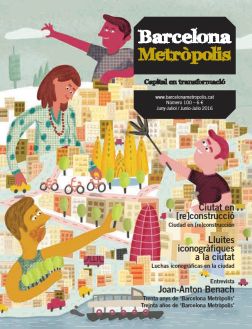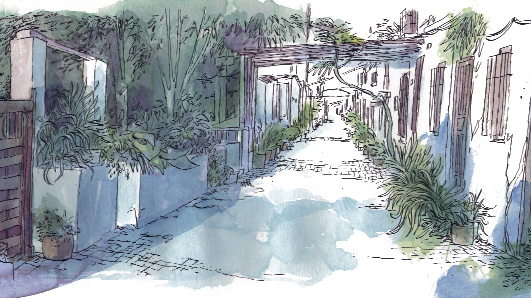This former town once had eighty laundries washing the clothes of Barcelona’s wealthy.
When I started to spend some time in Horta, I was seven years old and had never even uttered the word “laundry”. My parents put me down for the Salesian school in Horta because I had acetone breath and needed to be in an environment with fresh air. The acetone breath was awful. They made you pee onto a little piece of card and if it turned purple you weren’t allowed to eat chocolate. It wasn’t that difficult to get to Horta from Plaça Virrei Amat but until I was twelve I wasn’t allowed to go on my own. At that time I did know the first two syllables of the Catalan word for “laundry” (bugaderia): some of my classmates called a “cool” fast car a “buga”. They were the same kids who said “I’m going to my queo”, instead of “casa”, when they went home. They also had a parallel monetary system: a green 1,000 peseta note was a “talego” (sack) or a “lechuga” (lettuce). And a 100 peseta note, with its picture of the composer Manuel de Falla looking bald and scrawny, was a “gamba” (prawn). When I was in secondary school, around the age of 14, I started to compile all these new slang words in a notepad and a year or two later they were part of my everyday vocabulary. We always spoke in Spanish until all at once we’d realise from some strange expression that someone in the gang spoke Catalan at home. We were in the minority. Maybe seven or eight out of forty.
One of those words that gave me something of an epiphany and made me discover a Catalan-speaking classmate was “bugaderes”. “Bugawhat?” I asked. And he explained it to me. He was a local Horta lad and knew a lot of things about the neighbourhood that I hadn’t yet picked up on. Coming from him, the word “bugaderia” sounded a bit taboo. One afternoon he took me to a secret alleyway, the one with the laundry sinks. Two centuries ago, the dirty clothes of the wealthy folk of Barcelona were washed in the valley of Horta. Up to eighty laundries were in operation. Even today, when walking along the tucked away Carrer d’Aiguafreda (literally, Coldwater Street) one can imagine them scrubbing the laundry. It’s a magical place and it inspires the same response from everyone. It enchants you. I took the poet Josep Pedrals there because he was wandering the streets nearby unable to find it. I also took the band Txarango, who were looking for somewhere to take some group photos. The spell never fails. Everyone who goes there utters the same words under the laundry spell: you-can’t-believe-you’re-in-Barcelona. And it’s no exaggeration. You can’t believe it, but I’m always surprised that everyone feels the need to verbalise it.
Horta is not somewhere you happen to pass through. It’s situated on the edge of the city and you need a real reason to go there. Not for nothing is it named after a “vegetable garden”. Despite the fact that it is gradually dissolving into the metropolis of Barcelona, which it has formed part of for over a century, Horta still has a whiff of the countryside. Besides Carrer d’Aiguafreda, it has other nooks and crannies that cast the I-can’t-believe-we’re-in-Barcelona spell. You’ll say it or hear it on La Clota, at Parc del Laberint or in the gardens of the restored farmhouse of Can Fargas. Still today in Horta there are plots of cultivated land that no-one labels “organic” and more than one poultry yard. Horta is both a small town and a city district. Maybe that’s why the urban cacophony lives side by side with areas of unexpected peace and quiet and the wide thoroughfares of city planning projects meet the old higgledy streets and paths. There is more green than tarmac and there are possibly more trees in the gardens than along the streets.
The Horta that I discovered as a boy has changed a lot. It has lost some places and gained others, like everywhere. But it hasn’t gone downhill that much at all. We no longer live under the risk of exploding gas canisters (known as “Porcioles balls” after a Mayor of Barcelona), La Rambla del Carmel has a fabulous extension in the Parc de les Rieres d’Horta that covers the water collector and Plaça d’Eivissa is, at last, a welcoming place. As well as all this, many of my childhood friends who called fast cars “bugas” now speak to their children in Catalan. There is still bougainvillea all over the place, and for the Festa Major some locals dress up as laundrywomen, even though there are very few laundrettes left.
The Catalan gossip magazines should be based in Horta. Who better to spread the gossip than the descendants of an army of laundrywomen?




